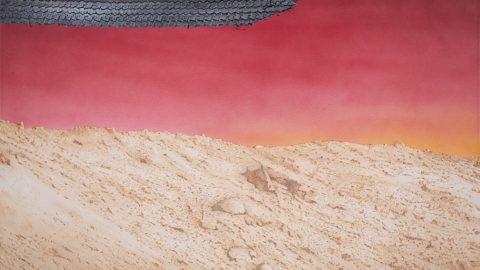On November 14, Gagosian opens an exhibition dedicated to the works of Ed Ruscha in New York, the artist who since the 60s has created a distinctive and ever-expanding lexicon of signs, symbols, images and words drawn from vernacular America. His visual expressions, sounds and concepts, such as the roadside gas station or the word “OOF,” have been incorporated into the American ethos. He has presented recurring images – the American flag, mountains, books and words – that are suggestive but never didactic, and the development of these images over his illustrious career exemplifies the ironic sophistication and subtlety with which he speaks through paint .
In these new paintings, Ruscha has chosen to revisit the flag, the mountain and the tyre. Flags entered Ruscha's visual vocabulary between 1985 and 1987, waving in the breeze over dramatic sunsets or triumphant blue skies, offset by thin black bar warning signs resembling censor stripes. The motif returned in OUR FLAG (2017) – currently on display in the Brooklyn Museum, which served as a polling station for the November election – where it disintegrated into shreds against a nearly black sky. The flag becomes distorted recently in RIPPLING FLAG (2020), this time awkwardly enlarged to extend beyond the right-hand frame, its fluid surface creating twisted shapes and shadows on the red and white stripes. In Top of Flag (2020), only a fraction of the banner is visible at the bottom of the canvas, surrounded by a gradation of shadow, almost as if the flag were a setting sun or a dim spotlight on a stage.
In the new mountain paintings, Ruscha features one of his archetypal snow ranges, but reverses one of the peaks so that it appears to descend from the sky. A shredded tire tread, or “alligator,” first referred to by Ruscha in his series of Psycho Spaghetti Western paintings, hovers over a barren, red-skied landscape in Hardscrabble (2020). These tire fragments also appeared in Blue Collar Tires (1992), which was part of the Course of Empire series, Ruscha's contribution to the American pavilion at the Venice Biennale in 2005. This was titled directly after the famous painting cycle by Thomas Cole (1834–36) depicting the same landscape over time as it developed from its pristine natural state, to finally fall, like the flags of Ruscha, into a state of ruin and decay.
A fully illustrated catalogue, with an essay by writer Tom McCarthy, will accompany the exhibition.
Ed Ruscha was born in 1937 in Omaha, Nebraska, and lives and works in Los Angeles. His work is collected by museums around the world. Exhibitions include Fifty Years of Painting, Haus der Kunst, Munich (2010, traveled to Moderna Museet, Stockholm, until 2010); Standard, Los Angeles County Museum of Art (2012-2013, traveled to Rose Art Museum, Brandeis University, Waltham, MA, through 2013); Los Angeles Apartments, Kunstmuseum Basel (2013); Featured: Ed Ruscha, J. Paul Getty Museum, Los Angeles (2013); 13th Lyon Biennial, France (2015); Ed Ruscha and the Great American West, de Young Museum, San Francisco (2016); Course of Empire, National Gallery, London (2018); Double Americanisms, Secession, Vienna (2018-19); and ARTIST ROOMS: Ed Ruscha, Tate Modern, London (2019-21).
Cover image: Ed Ruscha, Hardscrabble, 2020. Acrylic on canvas, 32 × 48 inches (81.3 × 122 cm)
© Ed Ruscha. Photo: Paul Ruscha
ED RUSCHA. Paintings – November 14, 2020–January 23, 2021 – Gagosian – 541 West 24th Street, New York





